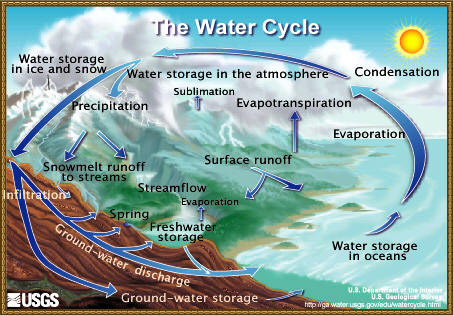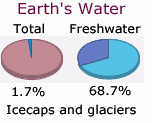Glaciers
Water is evaporated from the oceans and the land and returned as rain or snow, forming the hydrologic cycle.

Ice caps and global water distribution  |
Even though the amount of water locked up in glaciers and ice caps is a small percentage of all water on (and in) the Earth, it represents a large percentage of the world's total freshwater. As these charts and the data table show, the amount of water locked up in ice and snow is only about 1.7 percent of all water on Earth, but the majority of total freshwater on Earth, about 68.7 percent, is held in ice caps and glaciers. (Image credit: U. S. Geological Survey) |
| Water source | Water volume, in cubic miles | Water volume, in cubic kilometers | Percent of total water | Percent of total freshwater | |
|---|---|---|---|---|---|
| Ice caps, Glaciers, & Permanent snow | 5,773,000 | 24,064,000 | 1.7% | 68.7% | |
| Total global freshwater | 8,404,000 | 35,030,000 | 2.5% | -- | |
| Total global water | 332,500,000 | 1,386,000,000 | -- | -- | |
| Source: Gleick, P. H., 1996: Water resources. In Encyclopedia of Climate and Weather, ed. by S. H. Schneider, Oxford University Press, New York, vol. 2, pp.817-823. | |||||
Glaciers are plastically flowing masses of compacted snow and ice, often with significant transport of rock and other materials. Precipitation and accumulation must exceed the melting rate for glacial growth to occur.
Glaciers can be separated into two broad categories: Continental and Alpine. Continental glaciers form horizontal sheets, accumulating hundreds of meters in thickness - they flatten everything in their path. Alpine glaciers are smaller and are topographically controlled by existing mountain terrain, scouring and smoothing, but not obliterating, existing topographic features. Alpine glaciers also depend on changes in topographic relief and seasonal melting for their movement.
Glacial sediment, known as till, is characterized by its remarkable lack of sorting; fine-grained silt residing in close proximity to large boulders. Moraines are piles of rubble and sediment left behind by glacial retreat. Lateral and Terminal moraines are deposits of till at the sides and ending margins of glaciers, respectively. The finely-ground silt in a moraine is easily transported by adiabatic winds near glaciers and can form eolian deposits of great thicknesses in places such as Inner Mongolia, the Midwest U.S., and Northern Europe. This windblown material is called loess. Other glacial features include eskers, channels of poorly sorted rock deposited by subsurface rivers under or next to glaciers, and alluvial fans of poorly sorted material as outwash below terminal margins of glaciers.
Alpine valleys scoured by glacial action are easily identified by their peculiar U-shaped cross section and existence of odd 'hanging' valleys at former tributary junctions of glacial channels.
An important phenomenon related to continental glacial processes is isostasy. Continental glaciation places hundreds of meters of ice directly on crustal rock, which will deform under this weight over time. If the glacier melts and its weight is removed, isostatic compensation will occur, resulting in rebound of crustal rock. Evidence of isostacy occurs in areas freed from glacial burial, and can have an effect on mountain building and drainage patterns.
The cross-section diagram below (Anderson & Borns) shows a typical alpine glacier in cross-section. Note in particular the direction of fluid flow lines, the presence of shear planes along the bottom and at terminal tongue of the glacier, and the Equilibrium Line, a zone where ablation equals accumulation.
Though we normally think of continental glaciation in terms of late-Cenozoic ages (Pliocene - Pleistocene, 10,000 to 100,000 yrs or so), Geologists have collected paleo-tills on all present day continents, suggesting major periods of earlier glaciation at 280 My, (the Permian-Carboniferous boundary), 450 My (Ordovician), and the "Great Freeze" 700 My ago. The cause of these great continental glacial advances is still debated - the best theory at present links them to the Milankovitch cycle, a combination of changes in eccentricity, precession and tilt of Earth's orbit. However, this cycle may only act as a trigger, bringing about other events such as shifts in ocean currents, ocean evaporation, or vegetation growth into play.
| Water | Patterns of runoff | Geologic time periods |
Geophysics concepts
Reference
Lutgens & Tarbuck
Ch 9
| HyperPhysics | Bob Erdman, R Nave |